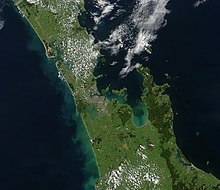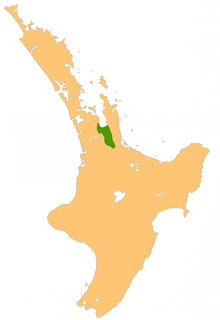This article needs additional citations for verification. (April 2015) |


The Hauraki Plains are a geographical feature and non-administrative area (though Hauraki Plains County Council existed from 1920 to 1989[1] and a statistical Area Unit remains)[2] located in the northern North Island of New Zealand, at the lower (northern) end of the Thames Valley. They are located 75 kilometres south-east of Auckland, at the foot of the Coromandel Peninsula and occupy the southern portion of a rift valley bounded on the north-west by the Hunua Ranges, to the east by the Coromandel and Kaimai ranges and to the west by a series of undulating hills which separate the plains from the much larger plains of the Waikato River. Broadly, the northern and southern parts of the Hauraki Plains are administered by the Hauraki District and the Matamata-Piako District respectively.
The alluvial plains have been built up by sediment deposited by the Piako and Waihou rivers, which flow north to reach the sea at the Firth of Thames, and earlier by the ancestral Waikato River. The resulting land is flat, peat-heavy, and partly swampy, which has been converted into excellent land for dairy farming.
Economically, the dairy farming is the leading primary industry, supported by other grassland farming. More recently, tourism in the Hauraki Plains region has been growing and the Hauraki Rail Trail, part of the New Zealand Cycle Trail, has been constructed in the Hauraki Plains.[3]
The largest town fully within the Plains is Ngatea, with a smaller settlement of Turua. The larger town of Paeroa is located on the eastern edge of the Hauraki Plains. While there is no defined geographical southern boundary to the Hauraki Plains, this is generally taken as being a line between the towns of Te Aroha and Morrinsville, approximately following State Highway 26.
- ^ "Hauraki–Coromandel region - Local government, 1876–2010". teara.govt.nz. Retrieved 6 January 2019.
- ^ "2013 Census map – QuickStats about a place". archive.stats.govt.nz. Retrieved 6 January 2019.
- ^ "Ministry of Economic Development". Tourism.govt.nz. 7 May 2014. Retrieved 3 April 2015.
© MMXXIII Rich X Search. We shall prevail. All rights reserved. Rich X Search
